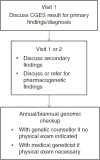Recommendations for the integration of genomics into clinical practice
- PMID: 27171546
- PMCID: PMC5557020
- DOI: 10.1038/gim.2016.17
Recommendations for the integration of genomics into clinical practice
Abstract
The introduction of diagnostic clinical genome and exome sequencing (CGES) is changing the scope of practice for clinical geneticists. Many large institutions are making a significant investment in infrastructure and technology, allowing clinicians to access CGES, especially as health-care coverage begins to extend to clinically indicated genomic sequencing-based tests. Translating and realizing the comprehensive clinical benefits of genomic medicine remain a key challenge for the current and future care of patients. With the increasing application of CGES, it is necessary for geneticists and other health-care providers to understand its benefits and limitations in order to interpret the clinical relevance of genomic variants identified in the context of health and disease. New, collaborative working relationships with specialists across diverse disciplines (e.g., clinicians, laboratorians, bioinformaticians) will undoubtedly be key attributes of the future practice of clinical genetics and may serve as an example for other specialties in medicine. These new skills and relationships will also inform the development of the future model of clinical genetics training curricula. To address the evolving role of the clinical geneticist in the rapidly changing climate of genomic medicine, two Clinical Genetics Think Tank meetings were held that brought together physicians, laboratorians, scientists, genetic counselors, trainees, and patients with experience in clinical genetics, genetic diagnostics, and genetics education. This article provides recommendations that will guide the integration of genomics into clinical practice.Genet Med 18 11, 1075-1084.
Conflict of interest statement
The authors of this manuscript declare no conflict of interest.
Figures


References
-
- Tjio JHLA. The chromosome number of man. Hereditas, Wiley On-Line Library. 1956;42:1–6. Available at: http://onlinelibrary.wiley.com/doi/10.1111/j.1601-5223.1956.tb03010.x/ab.... - DOI
-
- Lejeune J, Gautier M, Turpin R. Study of somatic chromosomes from 9 mongoloid children. [French] Etude des chromosomes somatiques de neuf enfants mongoliens. Comptes rendus hebdomadaires des seances de l’Academie des sciences. 1959 Mar 16;248(11):1721–1722. - PubMed
-
- Pinkel D, Gray JW, Trask B, van den Engh G, Fuscoe J, van Dekken H. Cytogenetic analysis by in situ hybridization with fluorescently labeled nucleic acid probes. Cold Spring Harb Symp Quant Biol. 1986;51(Pt 1):151–157. - PubMed
-
- Kolvraa S, Koch J, Gregersen N, et al. Application of fluorescence in situ hybridization techniques in clinical genetics: use of two alphoid repeat probes detecting the centromeres of chromosomes 13 and 21 or chromosomes 14 and 22, respectively. Clin Genet. 1991 Apr;39(4):278–286. - PubMed
-
- Magenis RE, Maslen CL, Smith L, Allen L, Sakai LY. Localization of the fibrillin (FBN) gene to chromosome 15, band q21.1. Genomics. 1991 Oct;11(2):346–351. - PubMed
Publication types
MeSH terms
Grants and funding
LinkOut - more resources
Full Text Sources
Other Literature Sources
Medical

